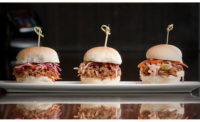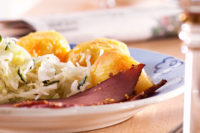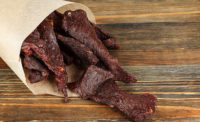Formulation Strategies
Protein's new role in snacks, appetizers and side dishes
Rising meat prices and changes in consumer eating patterns result in greater use of proteins beyond the traditional center of the plate.








Meat is increasingly ubiquitous. Once confined to the center of the plate, beef, pork, chicken, turkey and other proteins are emerging as popular snacks, appetizers and side dishes.
The dispersion results from such factors as a double-digit rise in meat prices — which has many consumers searching for less expensive ways to keep protein in their diets — and shopper interest in more convenient eating. Helping to fuel the movement is the rollout of new, alternative meat offerings from product vendors, retailers and foodservice operators.
“Consumers want to make their life easier and that is being manifested by the use of snack foods as a lunch, breakfast or dinner item,” says Harry Balzer, chief industry analyst with The NPD Group Inc., a Port Washington, N.Y.-based market research firm. “Making pot roast with green beans as a side dish and rolls and mashed potatoes takes money and effort.”
Foodservice adds flavor to new meat alternatives
With commodity meat prices on the upswing, restaurant operators are working to hold down costs by developing recipes that feature new uses of proteins apart from the center of the plate. “Chefs are getting more creative on how they are using meats,” says Kelly Weikel, director of consumer insights for Technomic Inc., a Chicago-based food and foodservice research and consulting firm. “Margins are tight, so restaurants often have to pass on their price increases to consumers. In some cases, they will discontinue items, but they also can offer less expensive meals by using proteins as ingredients in side dishes or appetizers,” Weikel says. Consumers, she notes, are more readily trading down from meat entrées when they compare, for instance, the price of a steak to an appetizer containing portions of steak. To capitalize on and fuel the trend, a wide range of chain and independent restaurants are adding protein-based appetizers and side dishes to menus. Morton’s The Steakhouse, in Houston, Texas, for instance, offers Pulled Pork Cheese Fries, which contains matchstick fries with BBQ pulled pork and cheddar cheese. Harper’s Restaurants, in Charlotte, N.C., serves Steamed Pork Buns featuring braised honey glazed pork belly with shaved scallions and hoisin-soy barbecue. On the Border, in Irving, Texas, offers Empanadas, five flaky homemade pastries stuffed with cheese and seasoned ground beef or chicken tinga and served with original queso. TGI Friday’s, in Exton, Pa., serves Barbecue Chicken Flatbread featuring crispy flatbread topped with tender pulled chicken breast in a smoky chipotle barbecue sauce. It is baked with Monterey jack and cheddar cheese and topped with fresh cilantro, red peppers and diced red onion. Famous Dave’s, in Bolingbrook, Ill., has BBQ Nachos, which contain house-smoked cheddar cheese, baked beans, chili, jalapenos and a choice of Texas beef brisket, Georgia chopped pork or barbecue pulled chicken. Brixx Wood Fired Pizza, in Charlotte, N.C., serves Fig and Prosciutto Flatbread containing prosciutto, caramelized onions, gorgonzola and walnuts on oven-roasted flatbread spread with fig jam and drizzled with honey. “More creative options are becoming available as consumers show interest in trying new and different foods and ingredients,” says Jana Mann, senior director of Data Trends at Datassential, a Chicago-based food industry research and consulting firm. “Chefs, meanwhile, are trying to make their products … unique to stand out from the crowd.” Starting a new traditionTraditional single-protein items that are increasingly being added to menus as appetizers include chicken wings. Wings are the top stand-alone protein and listed on 41 percent of appetizer menus, Mann notes. In addition, meatballs, which can be plated or added to sliders, are more readily available in a variety of protein types, including beef, turkey, chicken and pork. Sausages also are more popular as ingredients in appetizers, including on flatbread and as part of combinations, such as with jalapeno cheddar cheese. Meats, meanwhile, also are being added to poutine and fries to add heartiness, and thinly sliced Italian deli meats are being paired with cheese, nuts, fruits and sausage, Mann says. Protein-based side dishes, Weikel adds, also are becoming more varied, with meats and seafood being added to traditional selections, including macaroni and cheese. “Offering smaller-sized proteins selections make sense for foodservice outlets as there are consumers looking to have an appetizer or snack in lieu of meal and want it to be more substantial,” she says. Operators that offer attractive meat-based snacks are in position to generate larger revenues. Technomic notes consumers purchase just 20 percent of their snacks from foodservice outlets and most consumers are dissatisfied with the availability of menu offerings that can be ordered as snacks at both limited- and full-service restaurants. “Providing more innovative, healthy or portable snacks or a great variety of snacks overall may increase incremental traffic and sales,” Technomic states. “Appetizers are top of mind for both at home and away from home snack occasions.” Mann says snacks, as well as appetizers and side dishes, also will become increasingly novel and feature more ethnic selections, including recipes from Asia, South America and Central America. “Items are becoming more exciting as foodservice operators use more diverse proteins,” she says. “Chefs also are using different preparation methods and adding flavors that are unique to the meats.” |
That interest in convenience, as well as health concerns, helps to make meat snacks, including jerky and dried selections, a rapidly expanding sector. The Nielsen Co., a New York-based research firm, reports that sales of meat snacks in North America rose 15 percent for the year ending March 4, 2014.
A snack attack
“Non-sugary snacks closely aligned with meal replacement foods are showing strong growth, which signals a shift in a consumer mindset to one focused on health,” says Susan Dunn, Nielsen executive vice president, Global Professional Services, in the company’s “Snack Attack, What Consumers Are Reaching For Around The World” report. “While conventional cookies, cakes and confections categories still hold the majority share of snack sales, more innovation in the healthy snacking and portable food space is necessary to adjust to this changing dynamic.”
She says there is a “massive, untapped opportunity” for merchandisers to gain market share in the nutritious, portable, easy-to-eat meal-alternative market.
“Demand is primarily driven by taste and health considerations and consumers are not willing to compromise on either,” Dunn says. In a January 2014 nationally representative online survey of more than 1,500 consumers by Technomic Inc., a Chicago-based food and foodservice research and consulting firm, 32 percent of respondents reported they had broadened their definition of snacks over the past two years, and 24 percent now include more types of food in their snack mindset.
In addition, 45 percent say they replace either one or two meals per day with a snack and they are eating a wide variety of items as snacks, particularly appetizers. Half of all consumers, meanwhile, say they snack at least twice a day, a slight increase from 2012, and retail locations, including those that merchandise prepared and packaged foods, are top of mind for snacks.
“A big trend is the blur of the day part and meal part,” says Kelly Weikel, Technomic director of consumer insights. “It is making sense for consumers to have proteins, particularly if they use the appetizer or snack in lieu of a meal because they want it to be more substantial.”
Shoppers also are more willing to have meat-based snacks because they are familiar with the protein and see it as a risk-free option in terms of taste, Balzer says. Only 3 percent of respondents in an NPD Group survey reported that they had not eaten meat over the previous two weeks.
“Shoppers like meat and it is something they already know,” Balzer says. “They want to make their life easier and their food cheaper. The interest in convenience will never leave. It is just how it will manifest itself.”
A plethora of products
The emergence of meat snacks as a viable meal replacement is leading product developers to expand their options.
Jack Link’s, in Minong, Wis., for instance, offers 20 types of jerky sticks and plans to soon launch additional varieties, says Kevin Papacek, Jack Link’s director of marketing. The company, he notes, is focusing on offering diverse and exciting flavors.
Beef selections include Kung Pao, Teriyaki, Jalapeno Carne Seca, Chili Lime, Sweet and Hot, Cholula Hot Sauce, Peppered, Burrito, Sriracha, KC Masterpiece Barbecue, A.1. Steak Sauce, Steakhouse Recipe, Original, Original Hickory Smokehouse, Small Batch Original, Small Batch Teriyaki and Small Batch Peppered. Small Batch is thick slices of meat slow cooked in small batches and smoked in a traditional smokehouse.
Non-beef items are Sweet Teriyaki Turkey, Original Turkey and BBQ Pork. The company also is marketing other forms of jerky in a multitude of flavors, including Mini Snack Bites, Crinkle Cuts and Deli Cuts, along with a Beef and Cheese Combo pack and a Turkey and Cheese Combo pack.
Jack Link’s within the next few months intends to roll out Original Chicken Jerky, Original Chicken Strips, Pepperoni Sticks and Small Batch Hickory Bacon Jerky. Papacek says more consumers seek protein-rich snacks because they want to feel full longer.
To stress the health benefits, Jack Link’s also plans to update its packaging by including nutritional data in a more prominent location on the front of products. A major category challenge, Papacek says, is getting supermarkets and other mainstream retailers to aggressively market meat snacks. Convenience stores are the key merchandisers of jerky and other items.
He says retailers can generate greater interest in protein snacks by consistently launching new varieties and placing secondary displays in outlets, including counter-top arrays, to keep products in front of customers.
“Meat snacks need to be offered in multiple places, particularly because it is an impulse item,” Papacek says. “There should be a permanent home location within the snacking aisles, and snacks also should be merchandised in the front of stores and in end cap displays. Multiple points will increase sales.”
Sherry Frey, vice president of account services for the Nielsen Perishables Group, a Chicago-based market research company focusing on fresh foods, notes jerky and protein snacks have gone from being primarily “convenience store on-the-road items” to gourmet-quality meals.
“The evolution is being driven by consumers wanting more protein in their diets and more convenient options,” she says. “‘Snacking’ almost is a misnomer because snacks are becoming meals for people on the go, or for those eating alone at home and wanting smaller amounts of meats.”
Seeking wealth from health
That meal transformation leads to an expanding range of items also intended to meet consumers’ interest in health and wellness and lively eating experiences. Protein bars from Austin, Texas-based Epic, for instance, feature meats from 100 percent grass-fed animals. Selections include Bison Bacon, Beef, Beef Liver, Lamb and all-natural Turkey. The company also offers varieties of beef jerky, including Berry Blossom Mix, Toasted Coconut Mix, Harvest Nuts Mix and Mountain Medley Mix containing organic apples and roasted nuts.
Hinesburg, Vt.-based Vermont Smoke and Cure offers RealSticks protein sticks that are low in fat and free of preservatives and gluten. Varieties include Turkey Ancho, Turkey Honey Mustard, Turkey Pepperoni, Beef and Pork Chipotle, Beef and Pork Cracked Pepper and BBQ Beef.
In addition, Chicago-based Wild Ophelia Ltd. merchandises beef jerky sticks that also contain chocolate and Greensburg, Pa.-based Protos Foods Inc. offers Ostrim-branded meat sticks in a multitude of proteins. Selections include Beef and Ostrich, Beef and Elk, Turkey, as well as Beef and Ostrich Jerkee and Paleo Trail Mix containing turkey.
“There have always been a focus on meats for dinner and the center of the plate,” Frey says. “But operators now need to meet the changing interests of consumers, who are looking for smaller portions and ways to turn a snack into a meal.”
Many people, meanwhile, are interested in consuming meats in appetizers and side dishes instead of main courses. It is a way for diners to cope with the rising cost of proteins.
“More consumers are using portion control to deal with meat inflation,” says Patrick Fleming, director of marketing for the Des Moines, Iowa-based National Pork Board. “As a result, smaller servings are becoming more popular.”
Sales are on the upswing for such popular appetizers as chicken wings and cocktail franks, and proteins are increasingly included in vegetable trays. Datassential, a Chicago-based food industry research and consulting firm, reports that foodservice outlets are becoming particularly creative with protein appetizers and side dishes and also are offering added ethnic options as meal replacements.
Jana Mann, senior director for Datassential Menu Trends, says chefs want to develop recipes that are only available at their outlets in an effort to stand out from competitors (see sidebar).
Patience is a virtue
To sustain and increase meat sales, retailers must consistently launch new snack, appetizer and side dish options and aggressively market the items, analysts note. But Fleming says getting retailers and consumers to embrace the new roles of meat is a gradual process.
“The food industry always changes slowly,” he says. “Big changes take a long time. Merchandisers have to educate and inspire consumers with recipes and visuals to get them out of their normal ruts.”
Additional marketing vehicles that can help trigger interest in the new meat options include in-store signage and digital tools that provide consumers with recipes via phones or on websites, he says, noting it is important to use familiar recipes when introducing new uses.
“Meats in different forms will continue to grow,” Frey says. “People are buying less volume per trip, but don’t want less meat in their diets.”
Increases in meat prices and a focus by more shoppers on convenience, health and wellness, and exciting dining options are transforming proteins into more viable and attractive snack, appetizer and side dish options. With product manufacturers, retailers and foodservice operators developing additional offerings, consumer conversion to the new meal alternatives is set for further expansion.
Looking for a reprint of this article?
From high-res PDFs to custom plaques, order your copy today!











